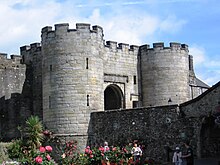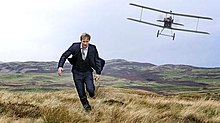The 39 Steps (2008 film)
It was written by Lizzie Mickery, directed by James Hawes, and filmed on location in Scotland, starring Rupert Penry-Jones, Lydia Leonard, David Haig, Eddie Marsan, and Patrick Malahide.
This adaptation is set on the eve of the First World War and sees mining engineer Richard Hannay caught up in an espionage conspiracy following the death of a British spy in his flat.
He finds a map in the back and takes a train to Scotland to prove Scudder right, attempting to decipher the code en route.
Chased by the police, the Germans and machine-gun-fire from a biplane, he encounters brother and sister Harry and Victoria Sinclair, a prospective Member of Parliament and a suffragette respectively, who believe him to be a Liberal spokesman there for a political rally in a nearby town.
Hannay reveals the contents of the notebook, leading to Sir George disclosing that a meeting of the committee is being held the next day at Stirling Castle to unveil new naval plans, matching part of the double code.
Hannay deduces that Sir George is the traitor, as he should have heard them when he was at Fisher's House, and, with his photographic memory, has escaped with the naval plans memorised.
To identify his rendezvous point with the Germans, they crack the remaining code, referring to the room they were previously imprisoned in at Longkeep Castle, and discover "39 steps" written in the notebook by Scudder using invisible ink.
The story concludes four months later, after the start of World War I, when Hannay, in an army officer's uniform, is waiting to meet someone at St Pancras railway station.
At the time of the announcement, Horsford said: "With this adaptation we wanted to stay faithful to the spirit and period of the book, but asked the writer Lizzie to feel free to re-imagine it for a modern audience more familiar with James Bond and Jason Bourne.
[3] A piece in The Observer stated that Mickery was "braced for complaints this Christmas from fans of previous screen portrayals", after basing her plot on the original book rather than the films.
[4] Differences from the book include the introduction of romance for Hannay, through suffragette and spy Victoria Sinclair, played by Lydia Leonard, and, according to Serena Davies of The Daily Telegraph, "a plot with so many twists and turns you almost need a degree in espionage to follow it".
[2] Locations used included the area around West Register Street in Edinburgh for the London scenes at the start of the film, Bo'ness railway station,[9] Kelvingrove Art Gallery and Museum for the interior scenes of St Pancras railway station, Glasgow City Chambers, Culross, Stirling Castle, the highlands of Argyll and Loch Katrine, used for the finale.
Willie Bennie, who sourced the vehicles, told the Daily Record: I knew they were wanting to include car chases to make the drama much more exciting to watch.
[8][15][16] Other minor mistakes included an anachronistic colour scheme for the British Railway carriages, and the appearance of a Philips 78 gramophone despite the company not being established until 1950.
[16] Ben Stephenson, Head of Drama Commissioning at the BBC, told The Daily Telegraph in reply to complaints about the inaccuracies: The question is: for the seven million people who watched it, did it feel authentic, did it create a sense of period?
[17] Overnight viewing figures estimated that the programme was seen by 7.3 million viewers (28% audience share) on 28 December 2008, against a Top Gear: Vietnam Special on BBC Two.
"[19] Damien Love of Sunday Herald felt the "tepid pace" was set by the casting of Penry-Jones, and that he "has a style reminiscent of the young Roger Moore, but without the vital, animating spark of self-deprecation.
"[20] Mick Hume of The Times said "The overall effect was to turn Buchan's blood and thunder tale into a pallid politically correct Enid Blyton story",[21] and The Independent 's Robert Hanks concluded his review by saying that "By the end, my impression was that several pages of the plot must have been eaten by a dog, or a bored actor, and the director had decided, sod it, nobody's going to keep watching this long.

